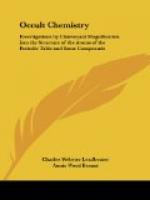The third sub-group, osmium, iridium and platinum, is, of course, more complicated in its composition, but its builders succeed in preserving the bar form, gaining the necessary increase by a multiplication of contained spheres within the ovoids. Osmium has one peculiarity: the ovoid marked a (XVIII, 4) takes the place of axis in the upper half of the bar, and the three ovoids, marked b, revolve round it. In the lower half, the four ovoids, c, revolve round the central axis. In platinum, we have marked two forms as platinum A and platinum B, the latter having two four-atomed spheres (XVIII, 6 b) in the place of the two triplets marked a. It may well be that what we have called platinum B is not a variety of platinum, but a new element, the addition of two atoms in a bar being exactly that which separates the other elements within each of the sub-groups. It will be noticed that the four lower sections of the bars are identical in all the members of this sub-group, each ovoid containing thirty atoms. The upper ring of ovoids in iridium and platinum A are also identical, but for the substitution, in platinum A, of a quartet for a triplet in the second and third ovoids; their cones are identical, containing twenty-one atoms, like those of silver and tin.
14 bars
of 245 atoms 3430
Atomic weight
189.55
Number weight
3430/18 190.55
OSMIUM (Plate XVIII, 4):
14 bars
of 247 atoms 3458
Atomic weight
191.11
Number weight
3458/18 192.11
IRIDIUM (Plate XVIII, 5):
14 bars
of 249 atoms 3486
Atomic weight
193.66
Number weight
3486/18 193.34
PLATINUM A (Plate XVIII, 6 a):
14 bars of 251 atoms 3514 Atomic weight ------ Number weight 3514/18 195.22 PLATINUM B (Plate XVIII, 6 b):
V a.—THE SPIKE GROUPS.
I place within this group lithium, potassium, rubidium, fluorine, and manganese, because of their similarity in internal composition. Manganese has fourteen spikes, arranged as in the iron group, but radiating from a central globe. Potassium has nine, rubidium has sixteen, in both cases radiating from a central globe. Lithium (Plate IV, 2) and fluorine (Plate IV, 3) are the two types which dominate the group, lithium supplying the spike which is reproduced in all of them, and fluorine the “nitrogen balloon” which appears in all save lithium. It will be seen that the natural affinities are strongly marked. They are all monads and paramagnetic; lithium, potassium and rubidium are positive, while fluorine and manganese are negative. We seem thus to have a pair, corresponding with each other, as in other cases, and the interperiodic group is left interperiodic and congruous within itself.
[Illustration: PLATE XIX.]




